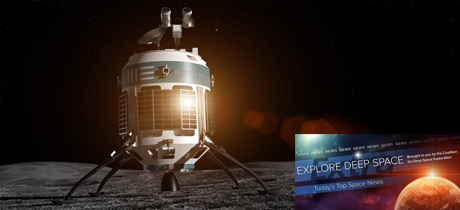In Today’s Deep Space Extra… NASA calls on the private sector for commercial lunar lander concepts. Recent modeling suggests Mars had an early ocean.
Human Space Exploration
NASA courts commercial options for Lunar Landers
NASAspaceflight.com (3/19): The space agency has issued a Request for Information seeking commercial interest in the development of rockets that could land on the moon. The request outlines NASA’s aim to better determine the state-of-art and maturity of lander capability in the private sector and mature its own requirements for a human-class lander. (A link to the RFI may be found here: https://www.fbo.gov/notices/f9ab19e797b4be15cb250816cbcee959
Space Science
Ancient oceans on Mars may have been older and shallower than thought
Space.com (3/19): Present day Mars is a cold, dry desert. Experts debate if, when and for how long the red planet might had a watery past. A new model points to the possibility oceans formed much earlier than previously thought and experienced disruption from the formation of massive volcanoes. Findings were published in the journal Nature.
Ideas for new NASA missions can now include spacecraft powered by plutonium
The Verge (3/19): NASA is lifting its ban on Plutonium 238 equipped radioisotope thermal electric generators for proposed planetary science missions. Recent limited supplies of plutonium, which is furnished by the U.S. Department of Energy, led to the ban for a class of NASA planetary missions called Discovery, some headed for destinations where solar power would be inadequate. Proposals can now incorporate a type of power system known as radioisotope thermoelectric generators, or RTGs.
There’s a small chance an asteroid will smack into Earth in 2135. NASA is working on a plan
Washington Post (3/19): NASA’s Planetary Defense Coordination Office is sizing up potential strategies for fending off an asteroid on a possible collision course with the Earth. Bennu, the Near-Earth Asteroid that NASA’s OSIRIS-REx mission will approach this year for reconnaissance and the acquisition of a small sample from, is providing a case study.
Wandering rogue moons may be as common as stars
Space.com (3/19): Giant Jupiter counts at least 67 moons. Possibly, other giant planets circling distant stars are similarly equipped. Gravitational tug of wars in an active solar system might pull some of those moons away and turn them rogue, according to a recent study published in the Astrophysical Journal.
Other News
SpaceX rival United Launch Alliance stakes future on new Vulcan rocket
Coalition Member in the News: United Launch Alliance (ULA)
CBS News (3/19): ULA plans to phase out its workhorse Atlas V and Delta 4 rockets in favor of a less-expensive, more powerful launcher known as Vulcan. ULA President Tory Bruno discusses the design of the Vulcan and the company’s plans.
Smallsat launch providers face pricing pressure from Chinese vehicles
Space News (3/19): Earlier this month, participants in the Satellite 2018 conference in Washington raised concerns that China may enter the small satellite launch market with sharply and unfairly reduced prices.
SpaceX may have big manufacturing plans for the Port of Los Angeles
Los Angeles Times (3/19): Hawthorne, California, based SpaceX has entered negotiations with the Port of Los Angeles to expand current facilities for the production of the Big Falcon Rocket, a commercial heavy lift launch vehicle, under a lease agreement. A vote of the Los Angeles Board of Harbor Commissioners is planned for a later date. The large rocket is so large it will require transport over the water.

